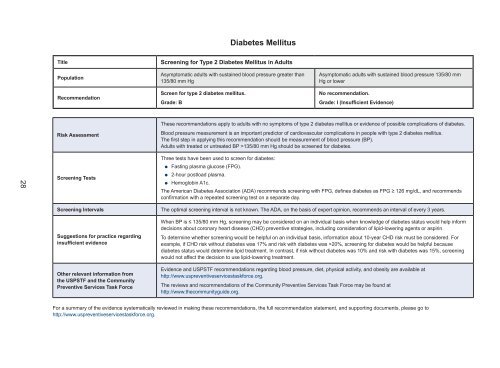1DpwC8F
1DpwC8F
1DpwC8F
You also want an ePaper? Increase the reach of your titles
YUMPU automatically turns print PDFs into web optimized ePapers that Google loves.
Diabetes Mellitus<br />
Title<br />
Population<br />
Recommendation<br />
Screening for Type 2 Diabetes Mellitus in Adults<br />
Asymptomatic adults with sustained blood pressure greater than<br />
135/80 mm Hg<br />
Screen for type 2 diabetes mellitus.<br />
Grade: B<br />
Asymptomatic adults with sustained blood pressure 135/80 mm<br />
Hg or lower<br />
No recommendation.<br />
Grade: I (Insufficient Evidence)<br />
Risk Assessment<br />
These recommendations apply to adults with no symptoms of type 2 diabetes mellitus or evidence of possible complications of diabetes.<br />
Blood pressure measurement is an important predictor of cardiovascular complications in people with type 2 diabetes mellitus.<br />
The first step in applying this recommendation should be measurement of blood pressure (BP).<br />
Adults with treated or untreated BP >135/80 mm Hg should be screened for diabetes.<br />
28<br />
Screening Tests<br />
Three tests have been used to screen for diabetes:<br />
●●<br />
●●<br />
●●<br />
Fasting plasma glucose (FPG).<br />
2-hour postload plasma.<br />
Hemoglobin A1c.<br />
The American Diabetes Association (ADA) recommends screening with FPG, defines diabetes as FPG ≥ 126 mg/dL, and recommends<br />
confirmation with a repeated screening test on a separate day.<br />
Screening Intervals<br />
Suggestions for practice regarding<br />
insufficient evidence<br />
Other relevant information from<br />
the USPSTF and the Community<br />
Preventive Services Task Force<br />
The optimal screening interval is not known. The ADA, on the basis of expert opinion, recommends an interval of every 3 years.<br />
When BP is ≤ 135/80 mm Hg, screening may be considered on an individual basis when knowledge of diabetes status would help inform<br />
decisions about coronary heart disease (CHD) preventive strategies, including consideration of lipid-lowering agents or aspirin.<br />
To determine whether screening would be helpful on an individual basis, information about 10-year CHD risk must be considered. For<br />
example, if CHD risk without diabetes was 17% and risk with diabetes was >20%, screening for diabetes would be helpful because<br />
diabetes status would determine lipid treatment. In contrast, if risk without diabetes was 10% and risk with diabetes was 15%, screening<br />
would not affect the decision to use lipid-lowering treatment.<br />
Evidence and USPSTF recommendations regarding blood pressure, diet, physical activity, and obesity are available at<br />
http://www.uspreventiveservicestaskforce.org.<br />
The reviews and recommendations of the Community Preventive Services Task Force may be found at<br />
http://www.thecommunityguide.org.<br />
For a summary of the evidence systematically reviewed in making these recommendations, the full recommendation statement, and supporting documents, please go to<br />
http://www.uspreventiveservicestaskforce.org.


